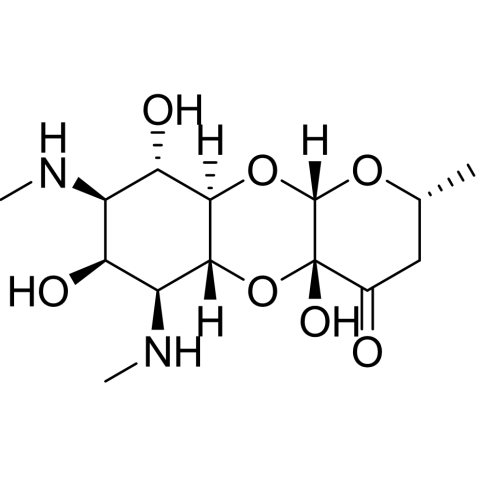Spectinomycin is an aminocyclitol antibiotic produced by Streptomyces spectabilis that inhibits bacterial protein synthesis. Historically, it was used to treat uncomplicated gonorrhea and in veterinary medicine. Today, its primary use is in molecular biology as a selective agent to identify bacteria that have incorporated specific genes. While it was once a common treatment for gonorrhea in humans, spectinomycin is no longer widely available for human use in the US. Spectinomycin was discovered in 1961 by researchers at the Upjohn Company, who isolated it from the bacterium Streptomyces spectabilis. Initially recognized as a broad-spectrum antibiotic, it was found to be highly effective in treating gonorrhea, especially in cases resistant to penicillin.
BRAND NAMES
Myspec: Available in India, manufactured by Neon Laboratories.
Spectin: Available in India, manufactured by Cipla.
Interspectin-L: A combination product with lincomycin used for veterinary purposes.
Spectinomycin Sulfate.
MECHANISM OF ACTION
Spectinomycin acts by binding to the 30S ribosomal subunit, inhibiting bacterial protein synthesis by disrupting the translocation process. It specifically targets a site on the 16S rRNA helix 34, preventing the movement of mRNA and tRNA within the ribosome. This interruption halts the production of essential proteins, thereby inhibiting bacterial growth.
PHARMACOKINETICS
Absorption
Spectinomycin is poorly absorbed when taken orally, so it is usually administered via intramuscular injection to achieve effective therapeutic levels in the body.
Distribution
The volume of distribution (Vd) of spectinomycin is approximately 0.3 to 0.5 liters per kilogram (L/kg), indicating that it is primarily distributed in the extracellular fluid with limited penetration into tissues.
Metabolism
Spectinomycin undergoes minimal metabolism in the body; it is primarily eliminated unchanged through the kidneys via renal excretion.
Excretion
In humans and other mammals, spectinomycin is excreted primarily and rapidly in the urine, mostly as the unchanged drug. The route of administration significantly affects the path of excretion, with oral doses resulting in fecal excretion due to poor absorption.
PHARMACODYNAMICS
Spectinomycin’s pharmacodynamics involve binding to the bacterial 30S ribosomal subunit, inhibiting protein synthesis by blocking the translocation step. This bacteriostatic action is mainly effective against certain gram-negative bacteria, such as Neisseria gonorrhoeae. While its mechanism is similar to aminoglycosides, spectinomycin targets a distinct site on the ribosome.
ADMINISTRATION
Spectinomycin is administered via intramuscular injection to achieve adequate blood levels, as oral absorption is poor. Due to its low oral bioavailability, spectinomycin is given by intramuscular injection for effective treatment. Spectinomycin is delivered through intramuscular injection since it is not well absorbed when taken by mouth. To ensure proper therapeutic effects, spectinomycin is typically administered as an intramuscular injection.
DOSAGE AND STRENGTH
Spectinomycin is commonly available in 2-gram vials for intramuscular injection.
For adults, the typical dosage for treating uncomplicated gonorrhea is a single 2-gram intramuscular injection.
Dosage may vary based on the infection type and patient factors, but it is usually given as a one-time dose for gonorrhea treatment.
FOOD INTERACTIONS
Spectinomycin has no known significant food interactions. However, since it is administered by intramuscular injection rather than orally, food intake does not typically affect its absorption or effectiveness.
DRUG INTERACTIONS
Spectinomycin has few known drug interactions, partly because it is mainly given by intramuscular injection and not metabolized extensively. However, caution is advised when used with other nephrotoxic or ototoxic drugs, as combined use may increase the risk of kidney or ear toxicity. Always seek advice from a healthcare professional before taking other medications alongside it.
CONTRAINDICATIONS
Spectinomycin is contraindicated in patients with a known hypersensitivity to the drug or any of its components. It should be used with caution in individuals with significant renal impairment, as reduced kidney function can increase the risk of toxicity. The drug is also used cautiously during pregnancy and breastfeeding, only when the potential benefits outweigh the risks, due to limited safety data. Patients with neuromuscular disorders, such as myasthenia gravis, should use spectinomycin carefully, as it may worsen muscle weakness. Additionally, caution is advised when spectinomycin is administered alongside other ototoxic or nephrotoxic medications, as this combination may increase the likelihood of ear or kidney damage.
SIDE EFFECTS
Pain, swelling, or redness at the injection site.
Nausea.
Dizziness.
Chills.
Fever.
Insomnia (trouble sleeping).
Urticaria (hives).
Difficulty breathing.
Swelling of the face, tongue, or throat.
A decrease in hemoglobin and hematocrit levels.
Reduced creatinine clearance.
OVERDOSE
Nausea and vomiting.
Dizziness or lightheadedness.
Headache.
Muscle weakness.
Kidney toxicity.
Hearing changes or ototoxicity.
Injection site pain or inflammation.
General fatigue or malaise.
TOXICITY
Spectinomycin has relatively low systemic toxicity but can cause allergic reactions, injection site pain, and gastrointestinal issues. More serious adverse effects may occur with high-dose intravenous (IV) administration or in patients with impaired kidney function. For human use, it has been primarily administered intramuscularly for gonorrhea and is now rarely used, especially in the United States.




